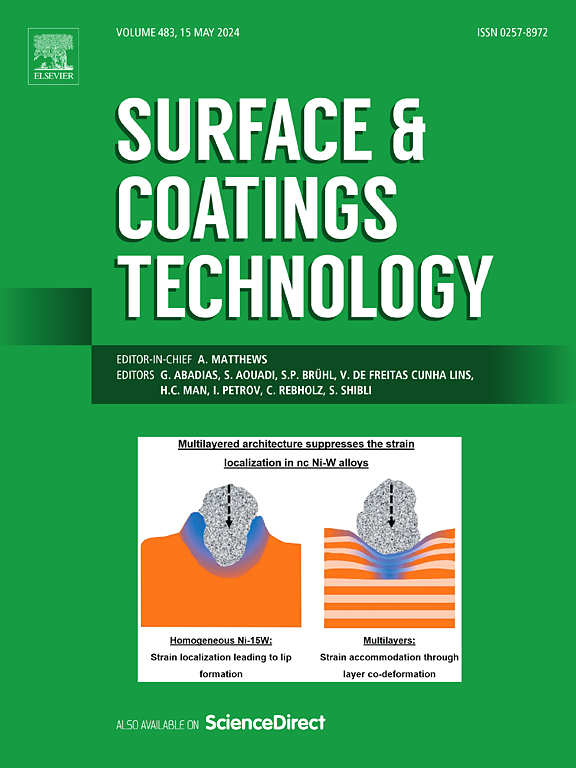激光表面熔化诱导粗晶粒组织增强IN625的抗氧化性
IF 6.1
2区 材料科学
Q1 MATERIALS SCIENCE, COATINGS & FILMS
引用次数: 0
摘要
研究了激光表面熔化IN625的显微组织和高温氧化特性。采用不同扫描速度的400 W连续激光器进行激光表面熔化。等温氧化实验分别在900℃空气中进行,时间间隔为2 h、10 h、25 h、50 h和100 h。采用x射线衍射(XRD)、扫描电镜(SEM)和电子背散射衍射(EBSD)分析了其微观结构演变。结果表明,激光表面熔化后,大块的富铌析出物被细化并均匀分布在γ基体内。铸态IN625中形成由Cr2O3和(Ni, Fe)Cr2O4尖晶石氧化物组成的混合氧化物,而激光表面熔化IN625中形成致密的Cr2O3垢。结果表明,氧化后的IN625在激光表面形成了半连续的Nb2O5带。进一步揭示了激光表面熔化后晶粒生长,在表面附近形成粗晶粒区。IN625的粗晶组织抑制了晶界扩散,与细晶组织相比,其氧化物生长较少,从而增强了抗氧化能力。本文章由计算机程序翻译,如有差异,请以英文原文为准。
Coarse grain structure induced by laser surface melting for enhanced oxidation resistance of IN625
This work examined the microstructure and high temperature oxidation characteristics of laser surface melted IN625. A 400 W continuous laser at various scanning speeds was used for laser surface melting. Isothermal oxidation experiments were conducted at time intervals of 2 h, 10 h, 25 h, 50 h and 100 h at 900 °C in air. The microstructure evolution was analysed by X-ray diffractometry (XRD), scanning electron microscopy (SEM) and electron backscatter diffraction (EBSD). It was shown that bulky Nb-rich precipitates were refined and evenly distributed within the γ matrix after laser surface melting. Mixed oxides, consisting of Cr2O3 and (Ni, Fe)Cr2O4 spinel oxides, were formed in the as-cast IN625 but a dense Cr2O3 scale was formed in the laser surface melted IN625. It was found that a semi-continuous Nb2O5 band was developed in the laser surface melted IN625 after oxidation. It was further revealed that grain growth occurred after laser surface melting, forming a coarse grain region near the surface. The coarse grain structure in IN625 suppresses grain boundary diffusion, resulting in less oxide growth compared to fine-grained counterparts, and enhances the oxidation resistance.
求助全文
通过发布文献求助,成功后即可免费获取论文全文。
去求助
来源期刊

Surface & Coatings Technology
工程技术-材料科学:膜
CiteScore
10.00
自引率
11.10%
发文量
921
审稿时长
19 days
期刊介绍:
Surface and Coatings Technology is an international archival journal publishing scientific papers on significant developments in surface and interface engineering to modify and improve the surface properties of materials for protection in demanding contact conditions or aggressive environments, or for enhanced functional performance. Contributions range from original scientific articles concerned with fundamental and applied aspects of research or direct applications of metallic, inorganic, organic and composite coatings, to invited reviews of current technology in specific areas. Papers submitted to this journal are expected to be in line with the following aspects in processes, and properties/performance:
A. Processes: Physical and chemical vapour deposition techniques, thermal and plasma spraying, surface modification by directed energy techniques such as ion, electron and laser beams, thermo-chemical treatment, wet chemical and electrochemical processes such as plating, sol-gel coating, anodization, plasma electrolytic oxidation, etc., but excluding painting.
B. Properties/performance: friction performance, wear resistance (e.g., abrasion, erosion, fretting, etc), corrosion and oxidation resistance, thermal protection, diffusion resistance, hydrophilicity/hydrophobicity, and properties relevant to smart materials behaviour and enhanced multifunctional performance for environmental, energy and medical applications, but excluding device aspects.
 求助内容:
求助内容: 应助结果提醒方式:
应助结果提醒方式:


